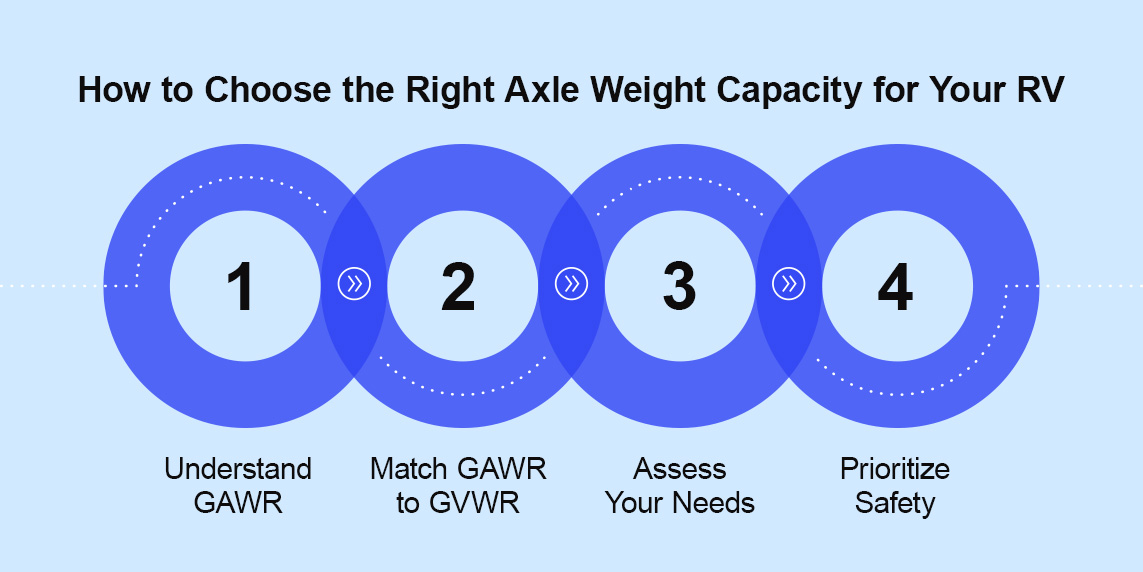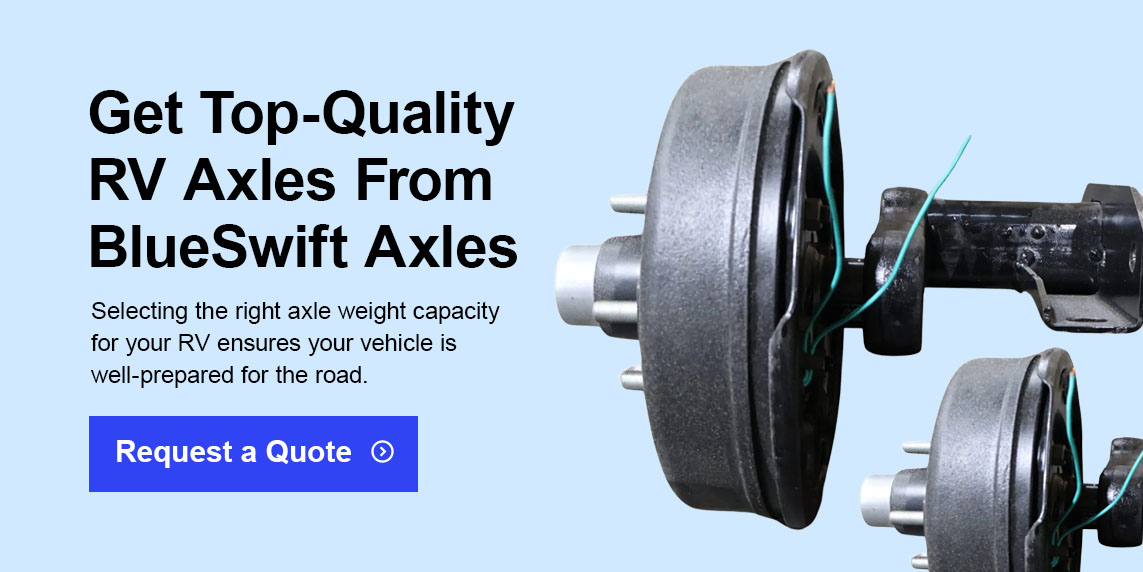Axles have a weight rating for the maximum capacity they can safely handle. Other components of your recreational vehicle (RV), such as tires, hitch and the vehicle itself, also have independent weight capacities. However, the weight capacity for your trailer or RV axle encompasses the vehicle’s full weight at its maximum limit. That is why it’s called the gross axle weight rating (GAWR).
Since axles carry the majority of the weight of your vehicle, it’s important to know their GAWR to avoid overloading the RV and exerting excessive stress on the axles. Understanding these limits helps you stay aware because overburdened axles can cause serious safety issues like suspension damage and a loss in axle camber.
This guide will help you determine your RV’s weight capacity and the matching axle rating to ensure safety and performance.
Types of Axles and Their Weight Capacities
Axles vary in design based on their primary purpose, such as heavy or light-duty applications. These differences also contribute to their unique advantages and performance capabilities. Here are the most common types of axles found on RVs and their weight capacities.
Straight Spring Axles
Spring axles are a common axle type found on RVs. Straight spring axles consist of the main axle beam attached to the wheel hub assembly, with the ends secured to traditional leaf springs. The stacked metal springs are excellent at absorbing shock and evenly distributing the vehicle’s weight.
The leaf spring suspension systems make these axles versatile and suitable for light, medium and heavy-duty applications. While the ride is less steady than torsion axles, spring axles are more reliable for heavy loads and uneven terrain. These axles have diverse weight capacities. Straight spring axles manufactured by Blueswift Axles range from 2,000 to 8,000 pounds.
Torsion Axles
Unlike spring axles, torsion axles for RVs rely on arms with a steel inner bar encased in rubber and attached to the spindle. The high-strength rubber absorbs shock and vibrations as the vehicle moves, providing higher efficiency and stability than leaf springs. While torsion axles offer an exceptionally smooth ride, they come at a higher price when compared to traditional spring axles.
Torsion axles have diverse weight capacities ranging from 2,000 to 10,000 pounds. This range in capacities allows torsion axles to be fitted on most all RV’s.
Drop Spring Axles
Drop axles are spring axles with a unique spindle drop design. Unlike standard spring axles, whose beam extends straight to the wheel hub, drop spring axles have spindles that drop the beam, lowering the trailer’s height. The drop improves stability and shock absorption, making the axle effective for loading and offloading applications.
Like the other axle types, drop axles have various weight capacities. At Blueswift Axles, we offer specific drop axle capacities, including the following:
- 3,500 pounds
- 5,200 pounds
- 6,000 pounds
- 7,000 pounds
- 8,000 pounds
How to Determine Your RV’s GAWR
You can confirm your RV axle weight capacity on the label, usually on the trailer tongue. You’ll also find the gross vehicle weight rating (GVWR). While the GAWR is the total weight that an axle can support. You must know how much both axles can support to avoid exceeding their limits.
To determine how much weight your loaded RV exerts on the axles, visit a nearby trailer weigh station to weigh your RV. If you can’t find any, locate an RV service center or dealership, as they would have scales. The same goes for truck stops. Since truck stops offer per-axle readings, you may need to prioritize dedicated RV centers to get all four corner readings, which is perfect for identifying imbalances.
Explore what the weighing process looks like below.
Truck Stop CAT Scale
CAT scales or truck scales are the most convenient option due to accessibility. You only need to pull into your local truck stop. The scales usually have three platforms designed to weigh the front, back and tag axles. Position your RV so that each axle rests on a separate platform.
If you have a motorhome, you can weigh it in one go but keep the truck and camper on separate scales if you’re towing an RV trailer. After, weigh the truck alone for the gross combination weight rating (GCWR) to ensure your tow vehicle and hitch are not overburdened.
Four Corner Scale
For more comprehensive weighing, visit a four-corner weigh station, usually at an RV center. Finding these can be inconvenient, especially if you’re far from your local center or RV club. However, these scales provide a complete picture of your RV’s weight and the weight on individual axles. Always compare the readings with your manufacturer’s ratings to ensure you haven’t exceeded axle capacity.
Choosing the Right Axle Weight Capacity for Your RV
Picking the right axle capacity is key for safe and efficient trailer use. It depends on your hauling needs and the laws.
Choosing RV axles rated to safely support your vehicle’s loaded weight is a critical decision with safety and performance implications. There are factors to consider when selecting an axle suitable for your RV, which include:
- A grasp of GAWR: As an RV owner, it’s important to understand the different weight rating terms associated with parts of your vehicle. For axles, GAWR refers to the maximum weight limit of a particular axle. For light-duty applications, consider axles rated up to 3,500 pounds. Axles ranging from 3,500 to 7,000 pounds can handle medium-duty and heavy-duty applications. A good rule of thumb is to ensure the GVWR does not exceed the combined weight capacity of all axles.
- Determining your needs: RVs range from travel trailers to 5th wheels, and each type weighs differently. Additional factors like belongings and passengers determine whether the vehicle carries full capacity or falls short. If your RV is often loaded to capacity, get an axle that matches that weight. The sum of your GAWR should match or exceed the fully loaded GVWR.
Legal Requirements for Safety
Federal and state governments regulate axle legal requirements in the United States to promote safety and reduce road damage. The federal government provides a baseline that dictates the maximum gross weight for vehicles on the interstate system, with the limits set at 20,000 pounds for single axles, 34,000 pounds for a tandem configuration and 80,000 pounds for the gross vehicle weight.
State governments also set their limits, which vary from state to state and can exceed or fall short of the federal limits. Stick to local regulations to ensure RV weight compliance since the state authorities enforce these laws.
Get Top-Quality RV Axles From BlueSwift Axles
Axle weight capacity directly affects vehicle safety, performance and longevity. Selecting the right axle weight capacity for your RV ensures your vehicle is well-prepared for the road. Considering the importance of staying within your axle weight limit, consult axle professionals if you’re in doubt about the right axle for your RV.
Blueswift Axles builds reliable trailer axles in 48 hours. Our experts respond fast and are ready to work with you to ensure you order the axle you need. Get a free quote today.


